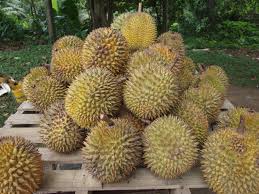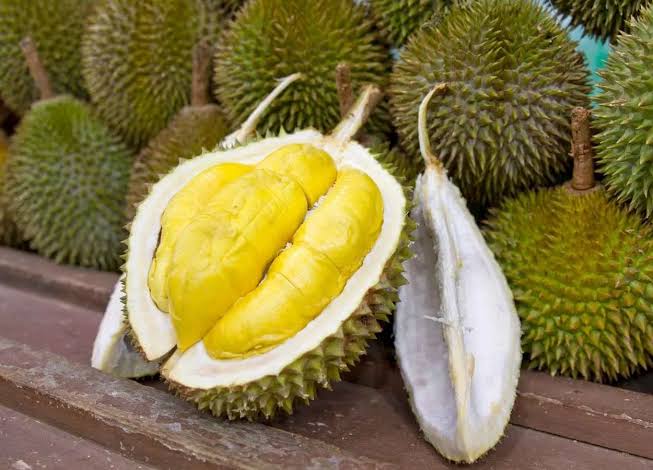Durians, scientifically known as Durio zibethinus, are renowned for their distinct characteristics and unique taste. These tropical fruits are often referred to as the “King of Fruits” due to their large size, thorn-covered husk, and strong odor. The scientific classification places Durians within the Malvaceae family, making them relatives of hibiscus and okra.
Durian trees, known for their height and evergreen nature, bear fruits that can grow to impressive sizes, ranging from football-sized to even larger. The spiky outer husk protects the creamy and custard-like flesh inside, which is the part consumed.
One of the defining features of Durians is their potent aroma. Some describe it as a blend of rotten onions, turpentine, and raw sewage. While the smell can be overpowering to some, Durian enthusiasts appreciate it as an integral part of the fruit’s charm.
The taste of Durians is a sensory adventure. The flesh is rich, buttery, and sweet, with a hint of bitterness. The combination of flavors creates a unique experience that leaves a lasting impression on those who indulge in this tropical delicacy.
Despite their popularity, Durians are prohibited in many hotels and public transportation systems due to their strong smell. Some people find it challenging to get past the initial odor, but those who do are often rewarded with a gastronomic delight.
In various Southeast Asian cultures, Durians are not just a fruit but a cultural symbol. They are associated with prosperity and good fortune, and their presence is considered auspicious in many ceremonies and celebrations.
Durians are not only consumed fresh; their versatility extends to being used in various culinary creations. From ice creams to pastries and savory dishes, Durians add a distinct and exotic flavor to a wide range of recipes.
Read Also: Disease Prevention and Health Management for Rabbits
The History of Durians

The history of Durians traces back to ancient times in Southeast Asia, where these unique fruits have been cultivated and cherished for centuries. The scientific name Durio reflects the genus to which these fruits belong, and their cultural significance has deep roots in the region.
Historical records indicate that Durians were known to travelers and traders as early as the 15th century. These fruits were not only appreciated for their taste but also valued for their ability to provide sustenance during long journeys. Indigenous communities in Southeast Asia, particularly in Malaysia, Thailand, Indonesia, and the Philippines, have long regarded Durians as a vital part of their diet.
Over the centuries, Durian cultivation spread across the region, adapting to various climates and soil conditions. The cultivation and consumption of Durians became intertwined with the cultural fabric of these societies, influencing traditional ceremonies, folklore, and culinary practices.
The “King of Fruits” earned its royal moniker not only due to its size but also because it became a symbol of abundance and prosperity. In some cultures, Durians were believed to bring good fortune and blessings, leading to their inclusion in various rituals and celebrations.
European explorers and colonizers encountered Durians during their voyages to Southeast Asia. While the strong odor initially repelled some, others were captivated by the unique taste. This led to Durians gaining recognition beyond the borders of their native lands.
In the modern era, Durians have become a sought-after commodity in international markets, with enthusiasts worldwide seeking out these exotic fruits. The global demand has prompted efforts to cultivate Durians in non-native regions, although the unique tropical conditions required for optimal growth pose challenges.
Despite their popularity, Durians remain a divisive fruit, with some people embracing their distinct flavor and aroma, while others find them challenging to appreciate. The history of Durians is a testament to the enduring cultural significance and culinary allure of this tropical delicacy.
The Nutritional Values of Durians
Durians, scientifically known as Durio, pack a nutritional punch, offering a range of essential nutrients. While they are renowned for their unique taste and aroma, their nutritional profile adds to their appeal.
1. Calories: Durians are energy-dense fruits, with a significant calorie content. A typical serving provides a substantial amount of calories, making them a satisfying and filling snack.
2. Carbohydrates: The primary macronutrient in Durians is carbohydrates, mainly in the form of natural sugars. This contributes to the sweet and creamy taste of the fruit.
3. Protein: While not particularly high in protein compared to other foods, Durians still provide a modest amount of this essential nutrient.
4. Fat: Durians are known for their richness, and a portion of the fat content comes from healthy monounsaturated fats. However, they also contain saturated fats, so moderation is key.
5. Fiber: Durians are a good source of dietary fiber, which aids in digestion and promotes a feeling of fullness. The fiber content contributes to the overall nutritional value of the fruit.
6. Vitamins: Durians are rich in various vitamins, including vitamin C, which is essential for immune function. They also contain B-vitamins like thiamine, riboflavin, and folate, playing crucial roles in energy metabolism.
7. Minerals: Durians supply important minerals such as potassium, magnesium, and copper. These minerals are essential for maintaining proper heart function, bone health, and overall well-being.
It’s worth noting that the nutritional composition of Durians can vary based on factors like the specific variety of Durian, ripeness, and growing conditions. While Durians offer a range of nutrients, individuals should be mindful of their high calorie and sugar content and consume them as part of a balanced diet.
Read Also: How to Foster Kits (Baby Rabbits) with Another Doe (Adult Female Rabbit)
Health Benefits of Durian Fruits

Durians, scientifically known as Durio, offer several potential health benefits, making them more than just a delicious tropical treat.
1. Rich in Nutrients: Durians are a nutrient-dense fruit, providing essential vitamins and minerals such as vitamin C, potassium, magnesium, and B-vitamins. These nutrients play vital roles in immune function, heart health, and overall well-being.
2. Antioxidant Properties: The fruit contains antioxidants that help neutralize free radicals in the body. Antioxidants contribute to reducing oxidative stress, which is associated with various chronic diseases and aging.
3. Boosts Immunity: The high vitamin C content in Durians supports a healthy immune system. Adequate vitamin C intake is crucial for the production of white blood cells and the body’s defense against infections.
4. Supports Digestive Health: Durians are a good source of dietary fiber, which aids in digestion and promotes regular bowel movements. Fiber also contributes to a feeling of fullness, potentially assisting in weight management.
5. Cardiovascular Health: Potassium and magnesium, present in Durians, are essential minerals for heart health. They help regulate blood pressure, maintain proper heart rhythm, and reduce the risk of cardiovascular diseases.
6. Boosts Energy Levels: The carbohydrates in Durians provide a quick and sustained source of energy. This can be beneficial for individuals engaging in physical activities or those in need of an energy boost.
7. Bone Health: Durians contain minerals like magnesium and copper, which are essential for maintaining strong and healthy bones. These minerals contribute to bone density and can help prevent conditions like osteoporosis.
8. Mood Regulation: The presence of B-vitamins, particularly thiamine and riboflavin, plays a role in mood regulation and cognitive function. Adequate intake of these vitamins is linked to better mental health.
It’s important to note that while Durians offer these potential health benefits, individuals should consume them in moderation as part of a balanced diet. Additionally, people with certain health conditions, such as diabetes or allergies, should exercise caution and consult with healthcare professionals before incorporating Durians into their diet.
How to Grow Durians (Growing Guide)
Growing Durians, scientifically known as Durio, requires attention to specific tropical conditions. Here’s a brief guide for cultivating these unique fruits:
1. Climate: Durian trees thrive in tropical climates with high temperatures and high humidity. They are sensitive to cold temperatures, so it’s crucial to ensure a consistently warm environment.
2. Soil: Durians prefer well-draining soil with a slightly acidic to neutral pH. The soil should be rich in organic matter. Adding compost or well-rotted manure can enhance soil fertility.
3. Sunlight: Durian trees require plenty of sunlight for optimal growth and fruit production. Plant them in a location where they can receive full sun exposure for most of the day.
4. Watering: Durian trees need regular watering, especially during dry periods. However, they are sensitive to waterlogged conditions, so well-draining soil is essential. Water the trees deeply but allow the soil to dry out between watering.
5. Fertilization: Fertilize Durian trees regularly with a balanced fertilizer containing essential nutrients. Apply the fertilizer during the growing season to support healthy foliage and fruit development.
6. Pruning: Pruning helps shape the tree and improve air circulation. Remove dead or diseased branches and any competing growth to encourage a strong and productive canopy.
7. Pollination: Durians are primarily insect-pollinated, often by flies and beetles. While many trees are self-pollinating, having multiple trees can enhance cross-pollination and increase fruit production.
8. Pests and Diseases: Keep an eye out for common pests like mites, aphids, and fruit borers. Regular inspection and appropriate pest control measures can help prevent infestations. Durians are also susceptible to certain fungal diseases, so maintaining good hygiene and proper spacing between trees is important.
9. Harvesting: Durians typically take several years to start fruiting. Harvest the fruits when they naturally fall or gently shake the tree to check for ripe ones. The distinctive odor and the slightly soft feel of the spiky husk are indicators of ripeness.
10. Patience: Growing Durians requires patience, as these trees can take up to a decade or more to reach maturity and produce abundant fruit. Be prepared for the long-term commitment involved in cultivating these iconic tropical fruits.
Successful Durian cultivation requires adherence to these guidelines and a deep understanding of the specific needs of these tropical trees. Local climate and soil conditions may vary, so it’s beneficial to seek advice from local agricultural experts or extension services for region-specific recommendations.
In conclusion, Durians, scientifically known as Durio zibethinus, are more than just a tropical fruit; they are a cultural icon with a rich and distinctive taste.
The interplay between the strong aroma and the creamy sweetness of the flesh creates a culinary experience that is both polarizing and cherished by those who appreciate the “King of Fruits.”
Read Also: Top 30 Exceptional Features That Makes 10GYM Stand Out





